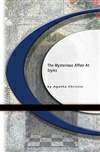Mysterious Affair at Styles
- 中文名:
- 斯代尔斯的怪事
- 作者:
- 阿加莎·克里斯蒂 Agatha Christie
- 类型:
- 小说经典
- 可下载格式:
- PDF
- 解压密码:
- www.qcenglish.com [点击复制]
- 收藏和分享斯代尔斯的怪事:
- 斯代尔斯的怪事(Mysterious Affair at Styles)简介:
- The Mysterious Affair at Styles is a detective novel by Agatha Christie. It was written in 1916 and was first published by John Lane in the US in October 1920 and in the UK by The Bodley Head (John Lane's UK company) on February 1 1921. The US edition retailed at $2.00 and the UK edition at seven shillings and sixpence (7/6).
It is Christie's first published novel, and introduces Hercule Poirot, Chief Inspector Japp and Captain Hastings. The story is told in first person by Hastings, and features many of the elements that, thanks to Christie, have become icons of the Golden Age of Detective Fiction. It is set in a large, isolated country manor. There are a half-dozen suspects, most of whom are hiding facts about themselves. The book includes maps of the house, the murder scene, and a drawing of a fragment of a will. Also, there are a number of red herrings and surprise plot twists.
The novel is set in England during World War I at Styles Court, an Essex country manor (also the setting of Curtain, Poirot's last case). Upon her husband's death, the wealthy widow, Emily Cavendish, inherited a life estate in Styles as well as the outright inheritance of the larger part of the late Mr. Cavendish's income. Mrs. Cavendish became Mrs. Inglethorp upon her recent remarriage to a much younger man, Alfred Inglethorp. Emily's two stepsons, John and Lawrence Cavendish, as well as John's wife Mary and several other people, also live at Styles. John Cavendish is the vested remainderman of Styles; that is, the property will pass to him automatically upon his stepmother's decease, as per his late father's will. The income left to Mrs Inglethorp by her late husband would be distributed as per Mrs. Inglethorp's own will.[1]
Late one night, the residents of Styles wake to find Emily Inglethorp dying of what proves to be strychnine poisoning. Captain Hastings, a house guest, enlists the help of his friend Hercule Poirot, who is staying in the nearby village, Styles St. Mary. Poirot pieces together events surrounding the murder. On the day she was killed, Emily Inglethorp was overheard arguing with someone, most likely her husband, Alfred, or her stepson, John. Afterwards, she seemed quite distressed and, apparently, made a new will — which no one can find. She ate little at dinner and retired early to her room with her document case. The case was later forced open by someone and a document removed. Alfred Inglethorp left Styles earlier in the evening and stayed overnight in the nearby village, so was not present when the poisoning occurred. Nobody can explain how or when the strychnine was administered to Mrs. Inglethorp.
At first, Alfred is the prime suspect. He has the most to gain financially from his wife's death, and, since he is so much younger than was Emily, the Cavendishes already suspect him as a fortune hunter. Evelyn Howard, Emily's companion, seems to hate him most of all. His behaviour, too, is suspicious; he openly purchased strychnine in the village before Emily was poisoned, and although he denies it, he refuses to provide an alibi. The police are keen to arrest him, but Poirot intervenes by proving he could not have purchased the poison. Scotland Yard police later arrest Emily Inglethorp’s oldest stepson, John Cavendish. He inherits under the terms of her will, and there is evidence to suggest he also had obtained poison.
Poirot clears Cavendish by proving it was, after all, Alfred Inglethorp who committed the crime, assisted by Evelyn Howard, who turns out to be his kissing cousin,[2] not his enemy. The guilty pair poisoned Emily by adding a precipitating agent, bromide (obtained from Mrs Inglethorp's sleeping powder), to her regular evening medicine, causing its normally innocuous strychnine constituents to sink to the bottom of the bottle where they were finally consumed in a single, lethal dose. Their plan had been for Alfred Inglethorp to incriminate himself with false evidence, which could then be refuted at his trial. Once acquitted, due to double jeopardy, he could not be tried for the crime a second time should any genuine evidence against him be subsequently discovered.

推荐书籍
-
双城记
小说经典
A Tale of Two Cities
Charles Dickens
查尔斯·狄更斯
-
麦琪的礼物
小说经典
The Gift of the Magi
O. Henry
欧·亨利
-
小兄弟
小说经典
Little Brother
Cory Doctorow
科利·多克托罗
-
太阳照常升起
小说经典
The Sun Also Rises
Ernest Hemingway
欧内斯特·海明威
-
嘉莉妹妹
小说经典
Sister Carrie
Theodore Dreiser
西奥多·德莱塞
-
歌德诗集
小说经典
The Poems of Goethe
Johann Wolfgang Von Goethe
歌德
排行书籍
-
了不起的盖茨比
小说经典
The Great Gatsby
F. Scott Fitzgerald
F·斯科特·菲茨杰拉德
-
麦田里的守望者
小说经典
The Catcher in the Rye
J.D. Salinger
J·D·塞林格
-
老人与海
小说经典
The Old Man and the Sea
Ernest Hemingway
欧内斯特·海明威
-
傲慢与偏见
小说经典
Pride and Prejudice
Jane Austen
简·奥斯丁
-
国富论
经济学
The Wealth of Nations
Adam Smith
亚当·斯密
-
乱世佳人
小说经典
Gone with the Wind
Margaret Mitchell
玛格丽特·米切尔
-
哈利·波特与魔法石
儿童读物
Harry Potter and the Philosopher’s Stone
J.K. Rowling
J.K.罗琳
-
百年孤独
小说经典
One Hundred Years of Solitude
Gabriel Garcia Marquez
加西亚·马尔克斯
-
失落的秘符
神秘惊悚
The Lost Symbol
Dan Brown
丹·布朗
-
英语语法手册
英语语法
English Grammar In Use
Raymond Murphy
雷蒙德·墨菲
-
秘密
励志成功
The Secret
Rhonda Byrne
朗达·拜恩
-
世界是平的
经济学
The World is Flat
Thomas Friedman
托马斯·弗里德曼
-
权力的游戏(冰与火之歌第一部)
科幻魔幻
A Game of Thrones (A Song of Ice and Fire, Book 1)
George R.R. Martin
乔治·R·R·马丁
-
万物简史
自然科学总论
A Short History of Nearly Everything
Bill Bryson
比尔·布莱森
-
谁动了我的奶酪
处事哲学
Who Moved My Cheese
Spencer Johnson
斯宾塞·约翰逊
